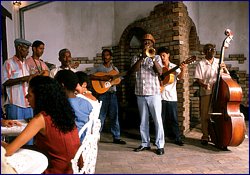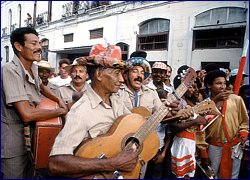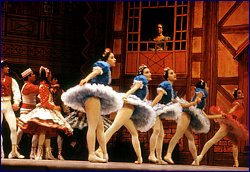Learning Holidays
A Quality Recognized Around the World
Centuries of blending different nations, customs and traditions have led to the unique Cuban views on life and expressions of culture. With its mixture of ethnic influences, Cuba has developed an exceptional character that is recognized around the world as distinct from other Caribbean countries. And it is a great place to stretch your cultural horizons. Study history. Learn Spanish. Take dancing lessons. Attend festivals.
For example, unique Spanish-American architecture from the 16th through 19th centuries remains an indelible—and educational—sign of Cuba’s cultural foundation. Two of the country’s ancient cities (Havana and Trinidad) have been declared world heritage sites by UNESCO. In addition, an extensive program of events, festivals and courses in world-class institutions and facilities provide opportunities to expand your world.
Also available are summer and winter courses in Cubadanza, Cuballet, Folkcuba and ballet. Havana also hosts the young classical ballet dancers’ competition.
| World heritage sites: |
 In addition to visiting the colonial sections of Havana and Trinidad, students of Cuban culture should also see the Valle de los Ingenios (Sugar Mill Valley) near Trinidad; the ruins of French coffee plantations in La Gran Piedra and Guantánamo; and San Pedro de la Roca del Morro Castle in Santiago de Cuba. These have all been declared UNESCO world heritage sites. Equally attractive are Bayamo, Santiago de Cuba, Camagüey, Sancti Spíritus, Cienfuegos and Remedios, where history, romance and nature live side by side.
In addition to visiting the colonial sections of Havana and Trinidad, students of Cuban culture should also see the Valle de los Ingenios (Sugar Mill Valley) near Trinidad; the ruins of French coffee plantations in La Gran Piedra and Guantánamo; and San Pedro de la Roca del Morro Castle in Santiago de Cuba. These have all been declared UNESCO world heritage sites. Equally attractive are Bayamo, Santiago de Cuba, Camagüey, Sancti Spíritus, Cienfuegos and Remedios, where history, romance and nature live side by side.
| Places of note: |
Outstanding cultural sites around the country are:
-Havana: Revolution Square, José Martí Memorial, the Capitol building; colonial fortresses; ancient churches; Colón cemetery; El Cacahual;
-Eastern mountains: ruins of French coffee plantations;
-Cienfuegos: Nuestra Señora de los Ángeles de Jagua Fortress;
-Santa Clara: memorial to Comandante Ernesto Che Guevara;
-Camagüey: La Merced church;
-Holguín: Villa Blanca de Gibara, the Chorro de Maíta archaeological site and Bariay Bay (where Christopher Columbus landed in Cuba);
-Santiago de Cuba: numerous historical sites, including the basilica of Señora de la Caridad d Cobre, where Ernest Hemingway left his Nobel Prize.
Museums, theatres and other institutions:
Cuba’s 265 museums, 120 art galleries and 70 theatres provide a never-ending cultural feast, complemented by 354 public libraries, 315 community culture centres and 46 art schools.
Many Cuban theatres are architectural marvels, among them the Milanés Theatre in Pinar del Río; the Amadeo Roldán Theatre and the Grand Theatre of Havana; the Sauto Theatre in Matanzas; La Caridad Theatre in Santa Clara; the Tomás Terry Theatre in Cienfuegos; and the Principal Theatres in the cities of Camagüey and Ciego de Ávila. Others are Casa de las Américas in Havana; Casa Iberoamericana in Holguín; the Heredia Theatre, Casa del Caribe and Ateneo y Casa de la Trova in Santiago de Cuba.
Museums include Havana’s Museum of the Revolution, City Museum, Decorative Arts Museum, Napoleonic Museum, Colonial Art Museum, Museum of Dance, Hemingway Museum and Morro-Cabaña Historical-Military Park. Other museums of note are:
-Matanzas: Pharmaceutical Museum;
-Trinidad: Romance Museum; Fight Against Bandits Museum;
-Camagüey: Ignacio Agramonte Museum;
-Gibara: Museum of Decorative Arts;
-Santiago de Cuba: Bacardí Museum, Museum of the Clandestine Movement, Siboney Farm, the 26th of July Historical Museum, Diego Velázquez’ House and the Rum and Piracy Museums.
| Cultural programs: |
 Sponsoring an extensive annual program of cultural activities are Paradiso (an organization promoting cultural tourism) and the Ministry of Culture’s Events and Festivals Bureau. The most outstanding of these is the International Ballet Festival in the cities of Havana and Camagüey; and Havana’s international festivals of New Latin American Cinema, Contemporary Music, Habaneras, Theatre and Dance. Others include the Golden Boleros and Beny Moré international festivals; Fire Festival in Santiago de Cuba; Festival of Ibero-American Culture and the Romerías de Mayo Festival in Holguín; the Cuban Identity Festival in Granma; and the Ibero-American Décima Festival in Las Tunas.
Sponsoring an extensive annual program of cultural activities are Paradiso (an organization promoting cultural tourism) and the Ministry of Culture’s Events and Festivals Bureau. The most outstanding of these is the International Ballet Festival in the cities of Havana and Camagüey; and Havana’s international festivals of New Latin American Cinema, Contemporary Music, Habaneras, Theatre and Dance. Others include the Golden Boleros and Beny Moré international festivals; Fire Festival in Santiago de Cuba; Festival of Ibero-American Culture and the Romerías de Mayo Festival in Holguín; the Cuban Identity Festival in Granma; and the Ibero-American Décima Festival in Las Tunas.
 24.24°C
24.24°C




